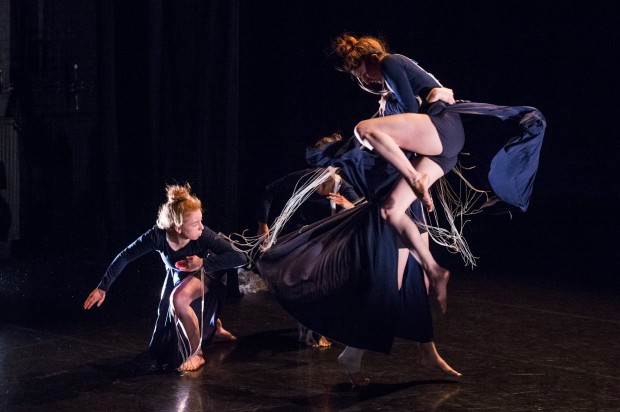I must confess. I approached this evening with a dormant bias towards MCDC’s (Michaela Cisarikova Dance Company) piece Riah. Having witnessed its birth at a triple bill in Longfield Hall last year, I was mesmerised by the great concept impressively envisioned on stage. It was new, it was raw, and it was ambitious.
‘Riah creates a world in which a person’s hair stores all their memories. Imagine having the ability to look at a single hair and view the memory attached, or pull that hair out and erase the memory for good.’
“I liked the image of hair, it’s very visual and dynamic,” Michaela Cisarikova told me last week. “There was a brief for an application to create something on the theme of memory, and that was the point where I started to cross the two together.” And that imagery was very clear on stage. Cecilia Berghäll, as Riah, dons a long chiffon scarf on her head, with flowing strands symbolising hair. The opening imagery is of her planted in a headstand under a spotlight. The other eight dancers converged around her, representing memories in beautiful white-laced black costumes, each tugging at the strands and interweaving through space in groups.
I’m always intrigued by how dancers translate their choreographer’s movements. Having seen MCDC’s dancers last year, and also working with Cisarikova individually (she was invited to showcase a solo extract performance of A Love Story at an event I curated), I became more aware of the techniques and execution behind her movements. As the dancers, sat in a line along the strands of hair, began a staccato like phrase – vibrating and freezing – I could only picture Cisarikova popping (Hip Hop dance technique) during A Love Story. A vibrant texture of movement that I felt, in comparison, was not truly emulated by her dancers. A minute distinction with a big impact.
Cisarikova spoke of a harmonious creative process when we first met last year. She “encourages her dancers to share their individual techniques and practices” in order to reach a “collaborative and versatile creative process”. Perhaps this is merely a different translation on different bodies. Regardless, there was something missing.
Graham Watts remarked that the “movement quality of choreography” was “in need of an edit”, and I must agree. Cisarikova’s Riah was a large scale production, and with that comes the troubles of synchronicity and the definition of movements. The choreography was lost in large ensembles, losing power at times or moves left unfinished in the rush to reach the next count. The ‘what’s-next?’ phenomenon.
But I must always return to this dormant bias. As what drove me to admire Riah was augmented – the full exploration of the concept.
This production transformed into a very cohesive narrative of a girl battling with her memories (the heavily bearded Nick Harman heralded the main role last year, making for an abstract piece). What we witnessed was the highs and lows of this character, with an underlying playfulness present throughout – well portrayed by Berghäll. We saw Riah flinging her hair playfully side to side, and the memories (dancers) after following the same pattern, transformed into a conflict under an aggressive techno-like score. It was as if the memories were battling for dominance; to be focal in the protagonists’ mind.
There was also an air of confusion. Highlighting this was a moment where Riah, facing two memories in a reverse ‘V’ formation, began a series of different interactions. Wearing a smile, she would lead a phrase which one memory would replicate in sync, and wearing a disorientating sadness, would follow a phrase led by the other memory. Gone is the blanket playfulness, and in comes individuality in the memories; showing the struggle of being in control and being controlled.

‘Riah’ in full flight. Photography by Charlotte Levy Photography
Imagery was Riah‘s strength. There’s a recurring intricate unwinding of the hands in a loop, as if untangling hair, that not only is created by the hands, but a certain hollowness in the chest, creating a hunchback-like figure. My last review described a certain moment as the peak of Riah. And so it remained. A visceral showing of the individual memories, after being plucked, coming to life in beautiful flowing yet rigid movements, encircled by strands of fabric – now fluorescent under a blackout. Riah, wielding a flashlight, explored each memory as if attempting to reconcile with them. Perhaps with an element of regret after the aggressive plucking of hair. A want to remember.
Riah has grown. Undoubtedly. No longer just an abstract piece, but a neat, complete, narrative driven production. Perhaps losing its edge at times, with the need to be a piece of dance theatre – substituting its former visceral nature for a more beautiful and elegant one (though elements of the visceral remained).
What Riah is, however, is a new and re-birthed imagination of an old idea; deserving its own acclamation. A roller-coaster of rediscovery – through red aggression and blue hues – and a coming at peace with a turbulent mind and memories.
